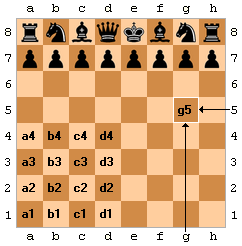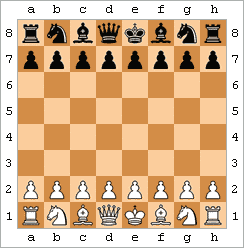Chess notation facts for kids
Chess notation is a special way to write down moves in a chess game. It's like taking notes during the game! After each player makes a move, they both write it down. This is a rule in all official chess tournaments. Writing down moves helps players remember what happened and study games later.
Long ago, people described moves in a very wordy way, like "The pawn of the king forward two houses." This was called descriptive notation. Each player described moves from their own side of the board. Today, we mostly use algebraic notation, which gives each square a unique name, no matter which side you are on.
Contents
Understanding Algebraic Notation
In algebraic notation, every square on the chess board has one special name. This name is made from a letter (the file) and a number (the rank). For example, 'e4' is the square where the 'e' file meets the '4th' rank.
When you write a move, you usually put the first letter of the piece, then the square it moves to.
- K for King
- Q for Queen
- R for Rook
- B for Bishop
- N for Knight (since 'K' is for King)
So, if a Queen moves to the square g5, you write Qg5. If a pawn moves, you don't write 'P'. So, a pawn moving to e4 is just e4.
Sometimes, two of the same pieces can move to the same square. To avoid confusion, you add an extra letter or number to show where the piece started. For example, Ngf3 means "the Knight from the 'g' file moves to f3."
Capturing Pieces
When a piece captures another, you add an "x" before the square it lands on.
- Bxf3 means "Bishop captures on f3."
If a pawn captures, you write the file the pawn started on, then the "x", then the square it lands on.
- exd5 means "pawn from the 'e' file captures on d5."
Special Moves and Symbols
- Pawn Promotion: When a pawn reaches the other side of the board (the 8th rank for White, or 1st rank for Black), it can become a Queen, Rook, Bishop, or Knight. You write the move, then the letter of the new piece. For example, e1Q means "pawn moves to e1 and becomes a Queen."
- Castling: This special move involves the King and a Rook.
* 0–0 means "kingside castling" (towards the King's side). * 0–0–0 means "queenside castling" (towards the Queen's side).
- Check and Checkmate:
* A move that puts the opponent's King in check gets a + sign. For example, Qh5+. * Checkmate, when the King cannot escape check, is shown with a # or ++. For example, Qxf7#.
- Game Results:
* 1–0 means White won. * 0–1 means Black won. * ½-½ means the game was a draw (a tie).
Adding Notes to Moves
Chess players often add symbols to describe how good or bad a move was:
- ! means a good move.
- !! means a very good move.
- ? means a bad move.
- ?? means a very bad move (sometimes called a blunder).
- !? means a creative move that might be good.
- ?! means a doubtful move.
Here's an example of a famous short game called the "Scholar's mate," with notes: 1. e2-e4 e7-e5 2. Qd1-h5?! Nb8-c6 3. Bf1-c4 Ng8-f6?? (3...Qe7 is better) 4. Qh5xf7# 1–0
And here is a famous short game using the more common short notation:
- Réti v Tartakower, Vienna 1910
- e4 c6
- d4 d5
- Nc3 dxe4
- Nxe4 Nf6
- Qd3?! e5?!
- dxe5 Qa5+
- Bd2 Qxe5
- 0-0-0 Nxe4??
- Qd8+!! Kxd8
- Bg5+ Kc7
- Bd8# 1–0
Figurine Notation
♖ ♜; ♘ ♞; ♗,♝; ♕,♛; ♔, ♚ Figurine notation is just like algebraic notation, but it uses small pictures (figurines) of the chess pieces instead of letters. This makes it easier for people from different countries to read, because they don't need to know the English letters for the pieces. It's often used in chess books and computer programs.
- Réti v Tartakower, Vienna 1910
- e4 c6
- d4 d5
- ♘c3 dxe4
- ♘xe4 ♞f6
- ♕d3?! e5?!
- dxe5 ♛a5+
- ♗d2 ♛xe5
- 0-0-0 ♞xe4??
- ♕d8+!! ♚xd8
- ♗g5+ ♚c7
- ♗d8# 1–0
Notation for Positions
Sometimes, you might want to write down just the pieces on the board at a certain moment, not the whole game. You can do this by listing the pieces for White and Black, along with their squares.
- White: Kf2; Qe3; Rf6, Rf7; Ne2; pawns d4, e5, h3.
- Black: Kc8; Qa2; Rf8, Rc7; Ba6; pawns d5, e6, f7, h4. White to play.
Images for kids
See also
 In Spanish: Notación (ajedrez) para niños
In Spanish: Notación (ajedrez) para niños





